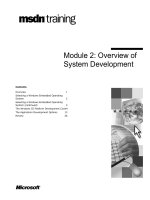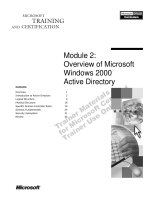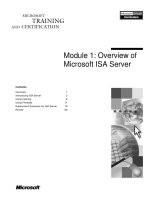overview of html and xml
Bạn đang xem bản rút gọn của tài liệu. Xem và tải ngay bản đầy đủ của tài liệu tại đây (109.46 KB, 22 trang )
Overview of HTML and XML
Overview of HTML and XML
Contents
Contents
■
History
History
■
Usage
Usage
■
Examples
Examples
■
Advantages
Advantages
■
Disadvantages
Disadvantages
HTML
HTML
■
What is HTML?
What is HTML?
■
Who created HTML?
Who created HTML?
■
What is the relationship between SGML and
What is the relationship between SGML and
HTML?
HTML?
■
What is the usage of HTML?
What is the usage of HTML?
■
What was the purpose of HTML?
What was the purpose of HTML?
What is HTML?
What is HTML?
■
HTML stands for Hyper Text Markup Language.
HTML stands for Hyper Text Markup Language.
–
Mark up is used to describe the pieces
Mark up is used to describe the pieces
and parts of a document.
and parts of a document.
■
The Key function of the markup is to add
The Key function of the markup is to add
labels to bits of text, and based on text the
labels to bits of text, and based on text the
output device can decide how best to format
output device can decide how best to format
the content.
the content.
Who created HTML?
Who created HTML?
■
HTML was created by Tim Berners-Lee at
HTML was created by Tim Berners-Lee at
European Laboratory for Particle Physics (CERN)
European Laboratory for Particle Physics (CERN)
in late 1980’s.
in late 1980’s.
■
In 1992, Marc Anderson Created MOSAIC,
In 1992, Marc Anderson Created MOSAIC,
first graphic interface for HTML documents
first graphic interface for HTML documents
at UIUC. (
at UIUC. (
University of Illinois at Urbana-
University of Illinois at Urbana-
Champaign)
Champaign)
Relationship with SGML
Relationship with SGML
■
SGML
SGML
(Standard Generalized Markup
(Standard Generalized Markup
Language)
Language)
was created by the folks at IBM in
was created by the folks at IBM in
the 1960’s.
the 1960’s.
–
SGML can truly be called the parent of HTML.
SGML can truly be called the parent of HTML.
–
SGML is an International Standard that describes
SGML is an International Standard that describes
the relationship between a document's content
the relationship between a document's content
and its structure.
and its structure.
Usage of HTML
Usage of HTML
■
More than 100 Million web pages
More than 100 Million web pages
■
Supported by all major browsers
Supported by all major browsers
■
Simple and Cheap
Simple and Cheap
Purpose of HTML
Purpose of HTML
■
To be simple enough to support authoring of web
To be simple enough to support authoring of web
pages.
pages.
■
Rich enough to support multimedia embedding in
Rich enough to support multimedia embedding in
documents
documents
■
Flexible enough to support hypertext linking
Flexible enough to support hypertext linking
XML
XML
■
What is XML?
What is XML?
■
What is the purpose of XML?
What is the purpose of XML?
■
What are the Advantages of XML?
What are the Advantages of XML?
■
What are the
What are the
Attributes
Attributes
and
and
Elements
Elements
of XML?
of XML?
What is XML?
What is XML?
■
XML stands for Extensible Markup Language
XML stands for Extensible Markup Language
■
XML is a markup language for documents
XML is a markup language for documents
containing structured information
containing structured information
■
XML is a language for describing other languages
XML is a language for describing other languages
Purpose of XML
Purpose of XML
■
XML was designed with some goals in mind.
XML was designed with some goals in mind.
–
Simple Enough for everyone to learn
Simple Enough for everyone to learn
–
Broad enough to support Rich Media
Broad enough to support Rich Media
–
Should not have any HTML drawbacks
Should not have any HTML drawbacks
–
Should allow the user to create his own
Should allow the user to create his own
tags
tags
–
should be able to interpret other
should be able to interpret other
languages
languages
Elements and Attributes
Elements and Attributes
■
Elements
Elements
–
An XML element is made up of a
An XML element is made up of a
start tag,
start tag,
an
an
end
end
tag,
tag,
and data in between. The start and end tags
and data in between. The start and end tags
describe the data in between, which is considered
describe the data in between, which is considered
the value of the element. E.g. The following
the value of the element. E.g. The following
element is a element with the value ”Boston”.
element is a element with the value ”Boston”.
–
<city>Boston</city>
<city>Boston</city>
Elements and Attributes
Elements and Attributes
■
Attributes
Attributes
–
An element can optionally contain one or more
An element can optionally contain one or more
attributes. An attribute is a name-value pair
attributes. An attribute is a name-value pair
separated by an equal sign (=)
separated by an equal sign (=)
■
<CITY ZIP=‘02115’>Boston</CITY>
<CITY ZIP=‘02115’>Boston</CITY>
■
In the above example, CITY ZIP is an
In the above example, CITY ZIP is an
attribute
attribute
of the “CITY” element
of the “CITY” element
HTML Example
HTML Example
Look at the same HTML Code shown. HTML tags
are for browsing; they are meant for interactions
between humans and computers.
<p><b>Mr. Joe Shmoe</b>
<br>
320 Berkeley Street
<br>
Boston, MA 02115</p>
Example Continued
When rendered, the HTML in the previous example looks
like this. As you can see, HTML tags describe how
something should render. They don't contain any
information about what the data is, they only describe
how it should look.
Mr. Joe Shmoe
320 Berkeley Street
Boston, MA 02115
Example of
Example of
XML
XML
Now let's look at some sample XML Code. With XML, you can understand the
meaning of the tags. More importantly, a computer can understand them as well.
<address>
<name>
<title>Mr.</title>
<first-name>Joe</first-name>
<last-name>Shmoe</last-name>
</name>
<street>320 Berkeley Street</street>
<city>Boston</city>
<state>MA</state>
<zipcode>02115</zipcode>
</address>
Example Continued
Example Continued
XML from the previous example might be rendered like
this. Notice that even though the tags are different, they
can still be rendered just like HTML.
Mr. Joe Shmoe
320 Berkeley Street
Boston, MA 02115
Advantages of HTML
Advantages of HTML
■
HTML document browser interfaces are
HTML document browser interfaces are
easy to build
easy to build
■
HTML is easy to learn because it is very
HTML is easy to learn because it is very
simple.
simple.
■
HTML works across systems that are
HTML works across systems that are
otehrwise unrelated
otehrwise unrelated
■
There are some specialized structures in
There are some specialized structures in
HTML
HTML
Disadvantages of HTML
Disadvantages of HTML
■
HTML’s Simplicity - a disadvatage as well
HTML’s Simplicity - a disadvatage as well
■
HTML is a weak presentation tool
HTML is a weak presentation tool
■
HTML is also a weak markup tool
HTML is also a weak markup tool
■
Linking in HTML is rudimentary
Linking in HTML is rudimentary
■
HTML is very instable
HTML is very instable
Advantages of XML
Advantages of XML
■
XML is an easy on-ramp to structured markup for
XML is an easy on-ramp to structured markup for
HTML users
HTML users
■
XML is a true subset of SGML designed for use on
XML is a true subset of SGML designed for use on
the Internet
the Internet
■
It is easy to write programs that can process XML
It is easy to write programs that can process XML
documents
documents
■
XML, like SGML, is not owned by any vendor of
XML, like SGML, is not owned by any vendor of
hardware or software
hardware or software
■
Current XML specification is 26 pages
Current XML specification is 26 pages
Disadvantages of XML
Disadvantages of XML
■
XML requires a processing application
XML requires a processing application
■
In future, XML would require different browsers
In future, XML would require different browsers
■
XML is comparatively new
XML is comparatively new
That’s it Folks !
That’s it Folks !
■
The END
The END









